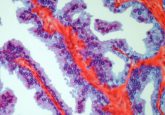Device that can ‘smell’ prostate cancer reaches important stage in development

A collaborative research effort from scientists at the University of Liverpool (UK) and the University of the West of England (Bristol, UK) has reached an important milestone in attempting to create a noninvasive prostate cancer test by creating a diagnostic urine test.
Recently published in the Journal of Breath Research, the study titled ‘The use of a gas chromatography (GC)-sensor system combined with advanced statistical methods towards the diagnosis of urological malignancies’, describes a diagnostic test that can ‘smell’ cancer in urine.
Working in tandem with researchers from the Bristol Urological Institute team at Southmead Hospital and Bristol Royal Infirmary, this pilot study included 155 men presenting to urology clinics. Of this group, 58 were diagnosed with prostate cancer, 24 with bladder cancer and 73 with hematuria or poor stream without cancer.
The results of the study indicate that the GC sensor system is able to successfully identify different patterns of volatile compounds that allow classification of urine samples from patients with urological cancers.
The GC sensor system, known as Odoreader, was developed by a team led by Chris Probert (University of Liverpool) and Norman Ratcliffe (UWE Bristol). Urine samples are inserted into the Odoreader and are then measured using algorithms developed by researchers at the University of Liverpool and UWE Bristol
“There is an urgent need to identify these cancers at an earlier stage when they are more treatable as the earlier a person is diagnosed the better. After further sample testing the next step is to take this technology and put it into a user-friendly format. With help from industry partners we will be able to further develop the Odoreader, which will enable it to be used where it is needed most; at a patient’s bedside, in a doctor’s surgery, in a clinic or Walk In Centre, providing fast, inexpensive, accurate results,” Probert explained.
Ratcliffe added: “There is currently no accurate test for prostate cancer, the vagaries of the PSA test indicators can sometimes result in unnecessary biopsies, resulting in psychological toll, risk of infection from the procedure and even sometimes missing cancer cases. Our aim is to create a test that avoids this procedure at initial diagnosis by detecting cancer in a noninvasive way by smelling the disease in men’s urine. A few years ago we did similar work to detect bladder cancer following a discovery that dogs could sniff out cancer. We have been using the Odoreader, which is like an electronic nose to sense the cancer.”
The Odoreader has a 30 meter column that allows urine compounds to travel through at different rates, thus separating the different components. This provides a readable format that is translated into an algorithm, enabling the detection of cancer by interpreting the patterns presented. For example, a prostate gland that is positioned very close to the bladder will give the urine profile a different algorithm if the patient has cancer.
Raj Prasad, Consultant Urologist at Southmead Hospital, North Bristol NHS Trust, said: “If this test succeeds at full medical trial it will revolutionize diagnostics. Even with detailed template biopsies there is a risk that we may fail to detect prostate cancer in some cases. Currently indicators such as diagnosed prostatomegaly (enlarged prostate) and unusually high PSA levels can lead to recommendations for biopsy if there is a concern that cancer may be prevalent. An accurate urine test would mean that many men who currently undergo prostate biopsy may not need to do so.”





